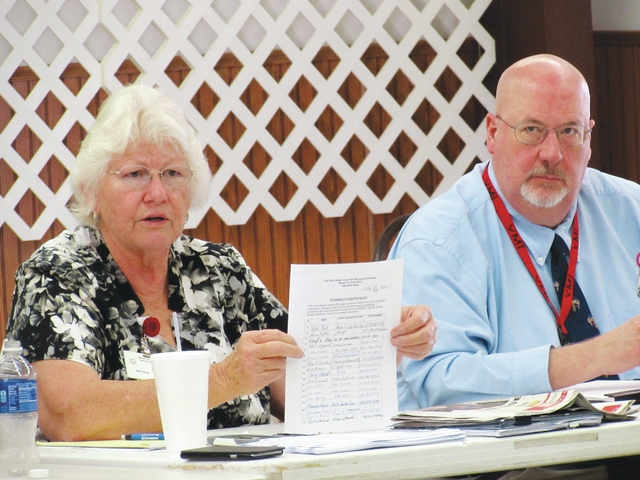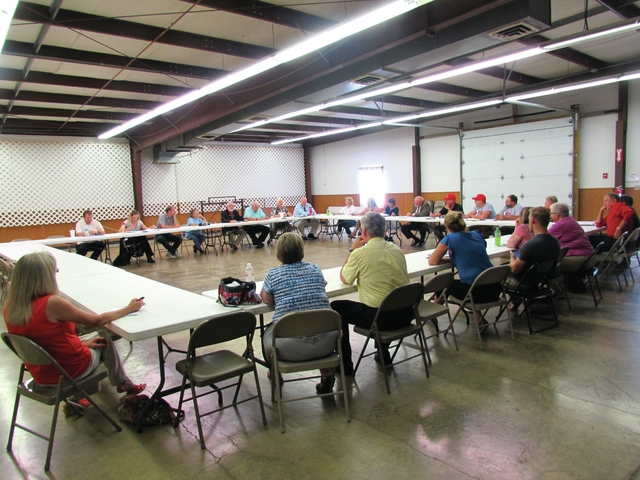GEORGETOWN — On a steamy Monday afternoon, numerous governmental and emergency assistance agencies met in Rhonemus Hall on the Brown County Fairgrounds as part of the Ohio Valley Long-Term Recovery Committee, in response to the disastrous flooding in Ripley and Georgetown that took three lives on July 18.
Similarly to the emergency briefing meeting, officials from the Brown County Commissioners, Emergency Management Services, Health Department, Health and Human Services, Red Cross, Team Rubicon, Helping Hands, and the Tri-State Community Organizations Active in Disaster (COAD) all attended, as did members of local churches and church groups.
The leaders of the meeting, Beth Nevel, Director of Public Safety in Brown County, and Jim Dinkel, chair of the Tri-State COAD and the OVLTRC, re-iterated many of the same points they made a week earlier, only this time to a different audience.
Nevel updated the officials that ten homes along Ripley Road in Union Township had suffered at least major damage, meaning that they had at least 18 inches of water on the first floor of the house. Three homes were listed as destroyed, with seven others suffering major damage.
Nevel said only one of the homes had flood insurance.
Nevel repeated to this audience that despite the tragedy of the events, the current disaster does not qualify for Federal Emergency Management Agency aid.
“The most asked question of me is when FEMA is going to be here,” Nevel said. “By the FEMA guidelines, FEMA is not going to be here, nor is the state of Ohio for individual assistance.”
FEMA guidelines state that a village or municipality needs at least 25 or more homes with major damage or destroyed to be eligible for state or federal aid, according to Nevel.
In addition to the homes destroyed, many roads, bridges, and culverts were damaged. The Brown County EMA told the News Democrat that municipalities have reported estimates for damages of $2,588,107.38. Add that number to the $792,000 estimate of county roads, bridges, and culverts from the Brown County Engineer’s office and that adds up to $3,380,107.38 in damages county wide.
Unfortunately, there is still unlikely to be any federal or state aid from FEMA or a similar agency for funding to help fix this crucial infrastructure.
Knowing that fact, the main theme of the meeting from Nevel and Dinkel was that the families who suffered damage to their homes, property, and lost lives, would need to rely on the local community to help pick them back up.
“There are no funds from the federal government or the state governments to cover (damages),” Dinkel said. “Increasingly they’re looking at individual communities to step up and help ourselves, and that’s precisely what we try to do through Tri-State COAD and the Ohio Valley Long Term Recovery Committee. We’re going to use everything that we’ve got here locally to help ourselves get back to normal.
“To be perfectly honest, that’s the way we used to do it all the time.”
Brown County Commissioner Barry Woodruff told a story about what he learned from asking his father how the community rebuilt after harsh flooding in the region in 1937.
“In talking to my father, who survived the 1937 flood, I asked him what happened back the and he said the community helped the community,” Woodruff said. “He said Red Cross showed up with a used table and four chairs. The rest of (the furniture for his family) came from the community.”
Nevel and Dinkel also touched on people who want to donate money to the Barrios and Kennard families as well as to the recovery effort.
In addition to the current bank accounts set up at Citizens Deposit Bank for Tony Barrios and his family as well as another fund for flood victims in Ripley, Dinkel advised the attendees of the meeting to spread the word that the best way to donate to the recovery effort is to the Ohio Valley Long Term Recovery Committee fund through Park National Bank.
“Everything’s being spent locally,” Dinkel said of the money in the funds.
Lastly, Dinkel re-iterated that this recovery process could take at least 18 months to complete, and that he would like to have weekly meetings. The next meeting is expected to take place on Aug. 2.




